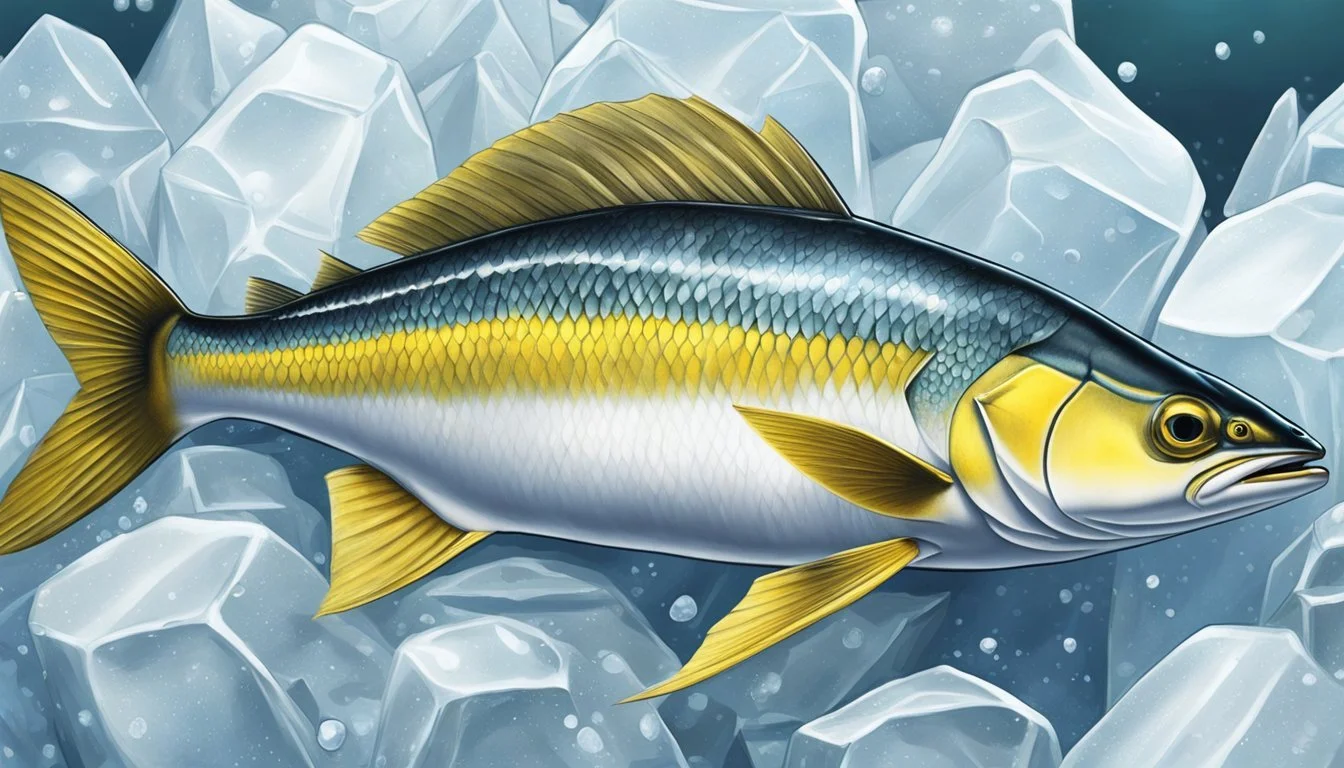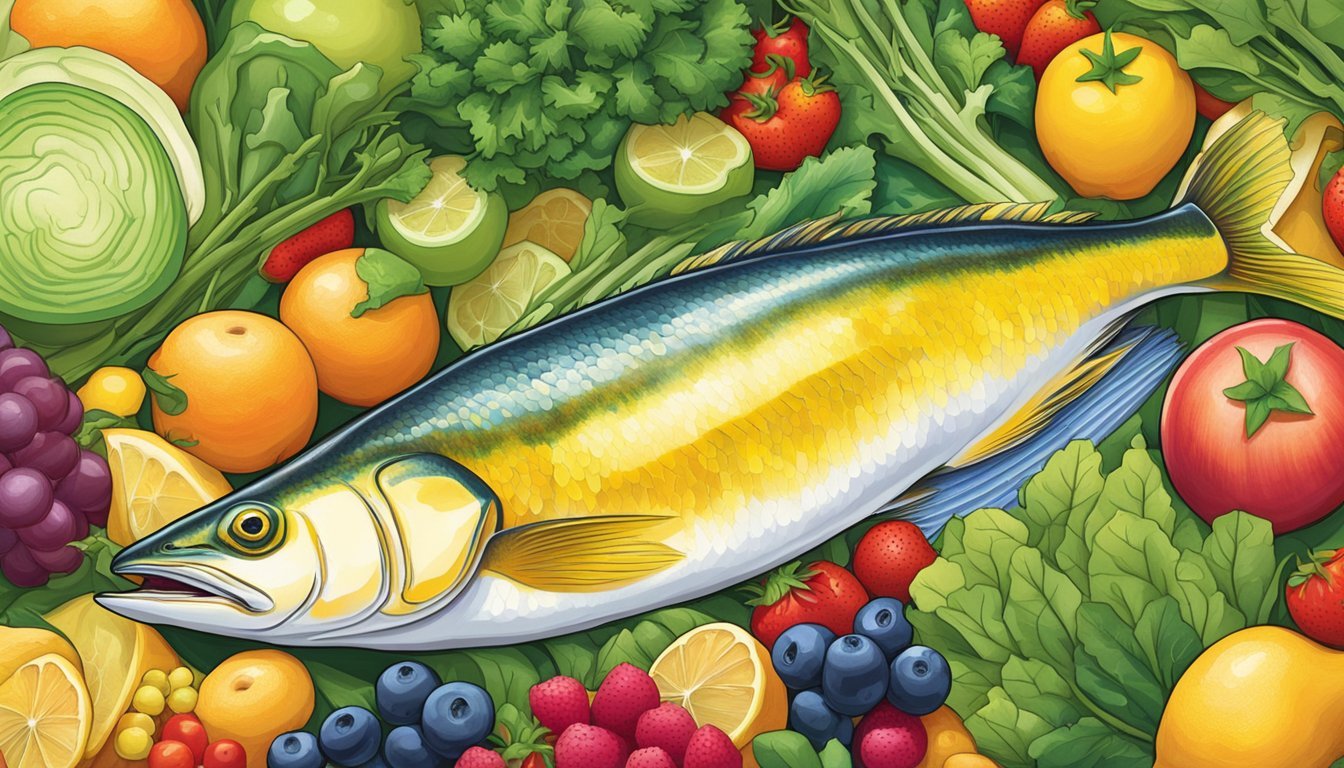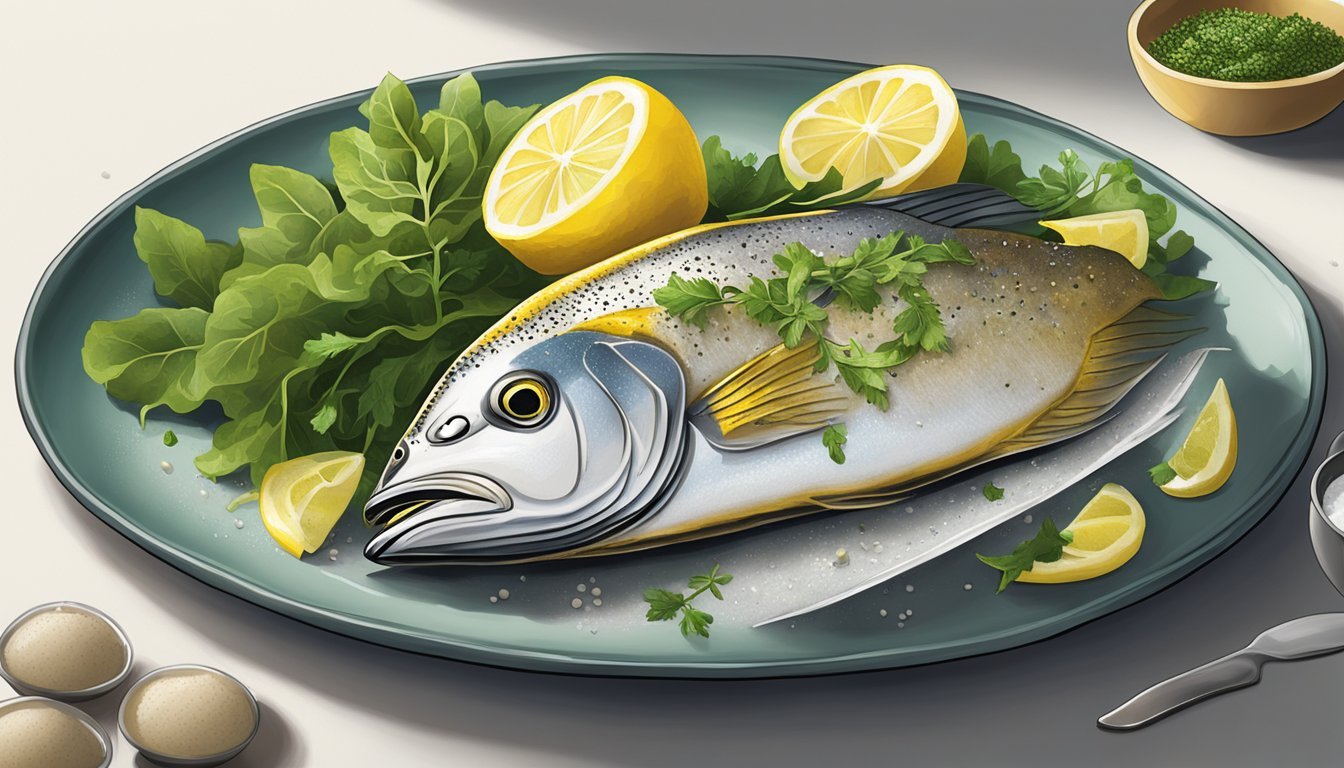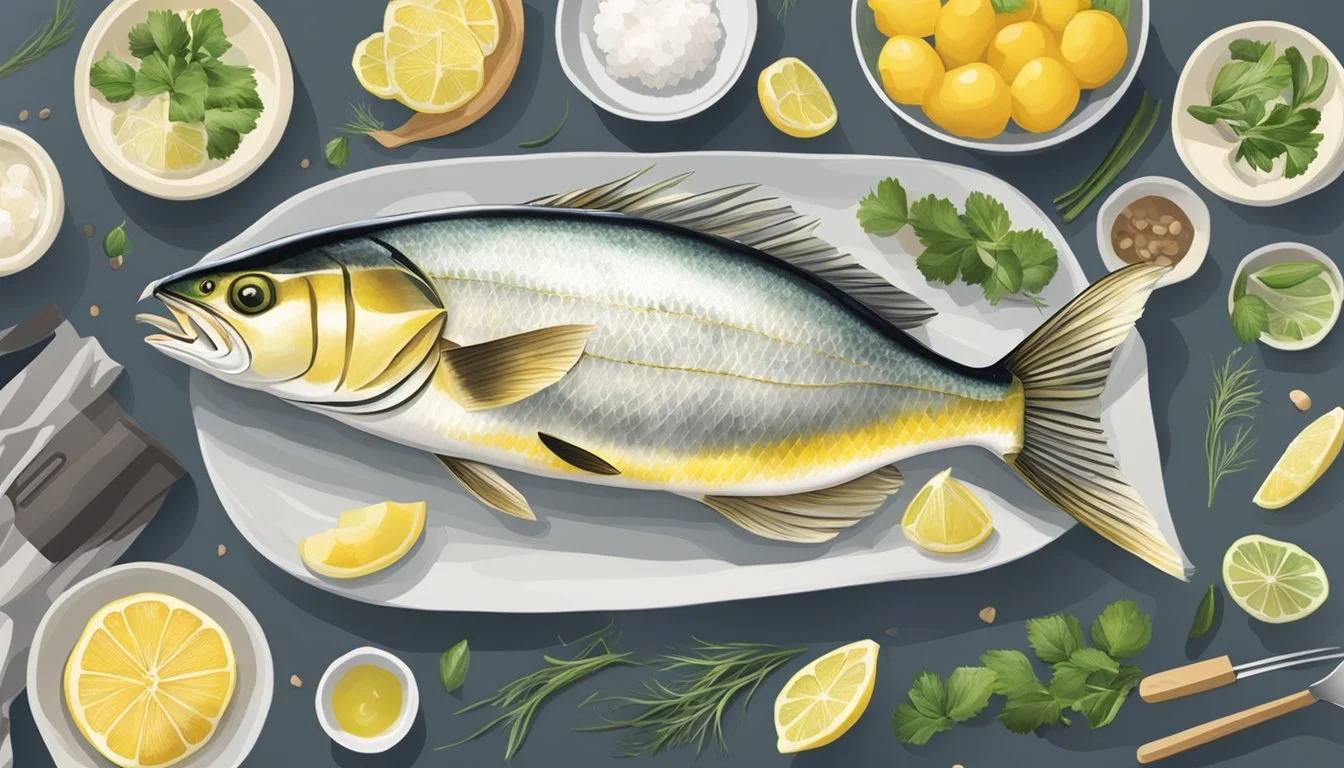How do You Eat Yellowtail Fish?
A Guide to Enjoying This Delicate Seafood
Yellowtail fish is a popular seafood (What wine goes well with seafood?) choice known for its versatility and distinctive flavor profile. The taste of yellowtail is often described as mild to moderate, with a rich, buttery texture that is savored by many seafood enthusiasts. It is a fatty fish (What wine goes well with fish?), which contributes to its unique taste that can lean towards a savory or slightly sour note, varying by type. Yellowtail's consistency is somewhat softer than that of tuna (What wine goes well with tuna?) but it remains a choice ingredient for a range of culinary applications.
In culinary preparations, yellowtail displays remarkable adaptability, lending itself to various cooking methods including grilling, baking, and pan-frying as well as being served raw. When cooked, the flesh turns opaque, and the natural flavors are enhanced through marination or seasoning. Common marinades may incorporate soy sauce, ginger, and sesame oil, which compliment the fish's inherent flavors. In its raw form, yellowtail is often sliced thinly and enjoyed as sashimi or sushi, typically accompanied by soy sauce, wasabi, and pickled ginger to balance the richness of the fish.
Whether it is pan-fried to achieve a crispy exterior while maintaining a flaky interior, or served as a classic component in sushi rolls, yellowtail can appeal to a broad audience. The fish's firmness prevents it from falling apart during cooking, making it a reliable choice for both amateur cooks and professional chefs. The variety of preparations available ensures that yellowtail can suit a wide range of palates and dining occasions.
Understanding Yellowtail Fish
Yellowtail fish refers to various species, including amberjack and jack in the Carangidae family. In sushi terminology, “yellowtail” often describes the fish Seriola quinqueradiata, also known as hamachi when young and buri when mature. Another popular species is Seriola lalandi. They are found in saltwater environments and are prized for their culinary qualities.
Characteristics
Family: Carangidae
Genus: Seriola
Yellowtail presents a mildly flavored profile with a buttery texture, marking it as a favorite in seafood cuisine. The fish is fatty, but this is where a lot of the flavors derive from.
Preparation
Sushi and Sashimi: Yellowtail's subtle flavor is greatly appreciated.
Cooked: Grilled or baked with simple seasonings like salt, pepper, lemon juice, and melted butter.
Nutritional Profile
Yellowtails are a healthy choice, as they provide beneficial omega-3 fatty acids and proteins. Their fat content contributes to the savory taste and mouthfeel, lending well to various cooking methods.
Notable Species
Hamachi: Typically young yellowtail, typically around 6 lbs.
Buri: The same species as hamachi but older and larger.
Yellowtail is a versatile ingredient that is both a delicacy and a common feature in sushi bars and restaurants. Its popularity extends from the palatable taste to its health benefits and flexible cooking options.
Nutritional Benefits
Yellowtail fish is a highly nutritious seafood option that offers a variety of health benefits due to its rich content of omega-3 fatty acids, proteins, healthy fats, and essential vitamins and minerals.
Omega-3 Fatty Acids Content
Yellowtail is an excellent source of omega-3 fatty acids, specifically EPA and DHA, which are known for their role in reducing inflammation, regulating blood pressure, and promoting heart health. Consistent intake of these fatty acids can support overall cardiovascular health and cognitive function.
Protein and Healthy Fats
Yellowtail fish is high in protein, which is crucial for muscle development and repair, while also being a source of healthy fats that contribute to satiety and metabolism. Additionally, the fats found in yellowtail are part of the unsaturated fats category, making them a healthier choice for maintaining good cholesterol levels.
Vitamin and Mineral Profile
This fish provides an impressive array of vitamins and minerals, including selenium, which is pivotal in supporting antioxidant activity and maintaining a robust immune system. Selenium also plays a role in thyroid hormone metabolism and reproductive health. Yellowtail's vitamin content enhances various bodily functions and furthers its health-promoting properties.
Culinary Techniques
Grilling: Yellowtail is frequently enjoyed grilled. The fish should be marinated in a mix of soy sauce, ginger, and garlic, then placed on a hot grill. Cook until the flesh turns opaque, ensuring a rich, smoky flavor.
Baking: Baking yellowtail results in a delicate, moist texture. Season the fillets with chosen spices and herbs, and bake in a preheated oven at 350°F. The cooking time varies depending on thickness, but it typically requires 10-15 minutes.
Searing: For a quick and flavorful option, searing yellowtail fillets in a hot pan seals in the flavors. The fish is cooked over high heat for a short duration, achieving a crispy exterior while maintaining tenderness inside.
Broiled: Broiling is ideal for achieving a caramelized top. Position the fish near the oven's broiler element and cook until golden brown, which often takes a few minutes. Monitor closely to prevent burning.
Method Temperature Time Note Grill Medium-high Varies Pre-marinate for richer flavor Bake 350°F 10-15 minutes Season appropriately Sear High A few minutes Crispy outside, tender inside Broil - Until golden Close monitoring needed
Careful attention to these methods ensures a deliciously prepared yellowtail. Each technique imparts a different texture and flavor profile to the fish, allowing it to be enjoyed in a variety of culinary applications.
Popular Yellowtail Dishes
Yellowtail fish, known for its rich, buttery flavor, shines across a range of cooking techniques. From the raw delicacy of sashimi to the heartiness of baked dishes, yellowtail adapts beautifully to various culinary styles. Here are some of the most popular ways to enjoy yellowtail dishes.
Sashimi and Sushi Variations
Yellowtail sashimi and sushi are staples in Japanese cuisine, celebrated for their delicate texture and taste. Sashimi typically involves thinly sliced, raw yellowtail, often served with soy sauce and wasabi. Sushi variations, including nigiri, feature small balls of rice topped with yellowtail slices. Yellowtail sushi can also come in the form of a spicy yellowtail roll, which includes spicy mayo and scallions to complement the fish's flavor.
Grilled Yellowtail with Herb Butter
For those who prefer cooked fish, grilled yellowtail with herb butter is a treat. The fish is grilled until it gets a charred exterior, while the inside stays moist and flaky. It's then topped with herb butter, which melts over the warm fish to add a rich, aromatic flavor. This dish makes frequent appearances on the menus of seaside restaurants.
Baked Yellowtail Delicacies
Baked yellowtail brings out the natural flavors of the fish, often enhanced with lemon and herbs. It can be propped up on lemon slices in the oven to infuse citrus notes throughout the cooking process. The result is a tender, flaky, and moist fillet. These dishes are both comforting and elegant, making them suitable for a range of dining occasions.
Yellowtail Soup and Stews
Yellowtail is also a fantastic ingredient in soups and stews, where it contributes a strong umami flavor. The firmness of the fish holds up well in broths and stews, allowing it to absorb the surrounding flavors without falling apart. These hearty preparations are perfect for colder weather or when one desires a more substantial meal.
Seasoning and Flavor Pairing
Selecting the appropriate seasonings and flavor pairings is essential for enhancing the delicate taste of yellowtail fish without overpowering its natural flavor. Key elements include the use of traditional Japanese condiments, a variety of herbs and spices, and the freshness of citrus and fruits.
Traditional Japanese Condiments
Japanese cuisine favors soy sauce and teriyaki sauce as staple condiments for yellowtail, accentuating its taste with a balance of umami, sweetness, and saltiness. Ponzu, a tangy sauce made with citrus like yuzu and soy, is often drizzled over yellowtail sashimi or grilled preparations, while wasabi and pickled ginger are common accompaniments that add a sharp, clean contrast to the fish's richness.
Soy Sauce: Offers salty, umami depth
Teriyaki Sauce: Provides a sweet, glazing quality
Ponzu: Combines citrus tartness with soy complexity
Yuzu: Imparts a unique, fragrant citrus note
Wasabi/Ginger: Delivers a piquant kick
Herbs and Spices
Yellowtail pairs well with a variety of herbs and spices. Garlic imparts a robust flavor when used in moderation, while pepper can add a gentle heat that complements the fish's texture. Integrating these flavors through a light marinade or a seasoning rub can infuse the yellowtail with complementary flavors while preserving its natural taste.
Garlic: Adds a strong, aromatic touch
Black Pepper: Provides warmth and spice
Citrus and Fruits
Citrus such as lemon and yuzu provide a bright and fresh dimension to yellowtail dishes, helping to cut through the richness of the fish. These can be used in the form of a squeeze of juice or zested over the top for a fragrant finish. Similarly, a mango salsa offers a sweet and tangy flavor pairing that complements the fish, especially when paired with a crisp, cold beer.
Lemon: Offers freshness and acidity
Mango Salsa: Brings a sweet and vibrant contrast
Beer: Can act as a palate cleanser between bites
Choosing and Preparing Yellowtail
When one decides to enjoy yellowtail, they should be knowledgeable about how to select a fresh fish and understand the various preparation methods. Achieving the best flavor and texture begins with these essential steps.
Selecting Quality Fish
A discerning buyer should look for bright and clear eyes, a sign of freshness. They should also check under the gill plate for a vibrant, reddish-pink color. Fresh yellowtail will have firm flesh and a slimy, reflective surface without a strong fishy odor. Ideally, fillets should have no discoloration, and scales should be intact if the skin is still on.
Preparation Methods
Preparing yellowtail starts by deciding whether to serve it skin-on or skinless. To remove the skin, one should gently slide a sharp knife between the skin and flesh. For sushi or sashimi, it is crucial to slice the meaty texture of the yellowtail fillet thinly against the grain. In sushi restaurants, this is a skill honed by chefs to perfection. For cooked preparations, marinating the fillets can infuse flavors, though one should take care not to overpower the delicate taste of the fish.
Cooking Techniques
Grilling: For a charred, smoky flavor, lightly brush the yellowtail with olive oil and season with kosher salt. Grilling should be done on medium-high heat until the fish is opaque throughout, usually for about 8-10 minutes depending on thickness.
Pan-Frying: Heats a pan to medium-high and add a conservative amount of oil to avoid sticking. Cook the yellowtail for 4-5 minutes on each side or until it's golden brown and the flesh flakes easily with a fork.
Baking: Season with choice spices and vegetables, and bake in a preheated oven. The cooking time should be about 10 minutes per inch of thickness so that it's thoroughly cooked without becoming dry.
In all methods, it's paramount to avoid overcooking to preserve the yellowtail's moist, meaty texture.
Serving and Presentation
When serving yellowtail fish, one must consider both taste and visual appeal, balancing complementary flavors and aesthetics to enhance the overall dining experience.
Accompaniments
To accompany yellowtail, several traditional items can enrich its buttery and clean flavor profile:
Soy Sauce: Provides a salty umami contrast to the fish's richness.
Wasabi: Offers a sharp, pungent heat that contrasts the fatty texture.
Sake: A traditional beverage pairing that complements yellowtail's flavors.
Nori Seaweed: Adds a briny depth when wrapped around slices of yellowtail.
Daikon: Often grated, this radish adds a fresh, zesty note to the fish.
Cucumber: Thinly sliced, cucumber brings a crisp, refreshing element.
Ponzu Sauce: A citrus-based sauce blending tart and savory notes, ideal for grilled yellowtail collar.
Plating Styles
For an engaging presentation, the style of plating plays a crucial role:
Grilled Yellowtail Collar: Rests splendidly as a centerpiece, with the edges crispy and golden brown. A side of grilled lemon can add a zing that highlights yellowtail's flavor.
Sashimi: Thin, clean cuts on a minimalist plate, often arranged over a bed of daikon slivers to emphasize the fish’s fresh, subtle taste.
Sushi: Elegantly placed atop rice, yellowtail can be wrapped with nori or garnished with a tiny dollop of wasabi.
Whole Fish: For a dramatic presentation, a yellowtail can be served whole, garnished with slices of cucumber or a light drizzle of ponzu sauce to cut through the richness.
Each element, from the chosen accompaniments to the plating style, should be purposeful, serving to complement and elevate the natural flavors of the yellowtail.
Pairing with Drinks
When enjoying yellowtail fish, the choice of beverage is crucial in enhancing the dining experience. Each drink—be it beer, sake, wine, or water—offers a unique complement to the fish's flavor profile.
Beer: A light and crisp beer can be an excellent choice for yellowtail. The carbonation helps cleanse the palate, and a pilsner or lager contrasts well with the richness of the fish.
Sake: This traditional Japanese beverage is a natural pairing for yellowtail. One should opt for a dry and clean-tasting sake to harmonize with the fish's delicate flavors without overwhelming them.
Wine: When it comes to wine, a chilled white with good acidity is ideal. Choices like Sauvignon Blanc or a dry Riesling can match the intensity of the yellowtail and balance its oiliness.
Sauvignon Blanc: Complements with its citrus notes.
Riesling: Pairs well with the fish's fatty profile.
Water: Sometimes, simplicity is key. Sparkling or still water ensures that the yellowtail's flavors are appreciated fully without the addition of competing tastes.
The table below summarizes the drink pairings for yellowtail fish:
Drink Type Suggested Option Reasoning Beer Pilsner or Lager Cleanses the palate; light contrast Sake Dry, Clean-tasting Complements without overpowering Wine Sauvignon Blanc, Riesling Balances oiliness; complements with acidity Water Sparkling or Still Allows pure appreciation of the fish
Choosing the right beverage to accompany yellowtail fish can elevate the meal, ensuring that both the fish and the drink are enjoyed to their fullest potential.
Health Considerations
Yellowtail fish, particularly known for its input to a balanced diet, harbors a rich repository of healthy fats. These fats are instrumental in promoting heart health and brain function. Most notably, yellowtail is an excellent source of omega-3 fatty acids, which are pivotal in reducing inflammation and may be associated with lower risk of heart disease.
Omega-3 Fatty Acids:
Essential for brain health
May lower cardiovascular risks
The fish’s content of omega-3s, along with other nutrients, underpins its standing as a healthful choice. Consuming yellowtail provides dietary benefits while also being a delightful culinary experience. However, consumers should consider their overall dietary pattern to ensure a well-rounded intake of nutrients.
When approaching yellowtail from a nutritional standpoint, it is important to recognize the dietary guidelines recommended by health authorities. An adequate weekly seafood intake is suggested, which includes lean fish like yellowtail, factored into balanced meal planning.
Recommended Seafood Intake:
At least 8 ounces per week
Adjustments for children and according to calorie needs
Individuals must remain cognizant of mercury levels in various seafood. Yellowtail fish generally fall into a category with moderate mercury levels, which guides the frequency of consumption to maintain a healthful diet.
In summary, incorporating yellowtail into one's diet can offer multiple health benefits due to its content of healthy fats and omega-3 fatty acids. It is recommended to consume seafood like yellowtail in moderation, aligning with one’s dietary requirements and guidelines.
Sustainable Fishing and Conservation
When considering the consumption of yellowtail, or any fish, sustainable fishing practices are crucial for the conservation of marine life and ecosystem health. They must prioritize maintaining fish populations, preserving their habitats, and ensuring that the fishing industry remains viable for future generations.
Selective fishing methods: To protect the yellowtail species, it’s important to employ fishing methods that minimize bycatch, or the unintentional capture of non-target species. Selective gear like hooks and lines are often preferred over non-selective gear like trawls or gillnets.
Fishery management: Effective management of yellowtail stocks involves setting quotas and size limits to prevent overfishing. It may also require seasonal closures to allow the fish to reproduce undisturbed.
Aquaculture practices: Yellowtail aquaculture should be sustainable and responsibly managed. It involves regulating stocking densities to prevent disease and managing feed sustainably to avoid overdependence on wild fish for fishmeal.
Consumer choice: As a consumer, one can support sustainable practices by:
Choosing to buy yellowtail with sustainability certifications (e.g., MSC-certified)
Opting for fish from fisheries that follow strict environmental guidelines
It's essential for consumers, the fishing industry, regulatory agencies, and conservationists to work together to ensure the long-term sustainability of yellowtail fisheries. Fishing practices and aquaculture methods must evolve continually to minimize environmental impact and maintain the integrity of marine ecosystems.
Cultural Significance
In Japan, yellowtail fish, known as Hamachi when young, holds a deep cultural significance. Revered for its rich flavor, it is a common star in sushi and sashimi dishes. Yellowtail is often celebrated in Japanese cuisine for both its culinary appeal and its symbolism. It is traditionally associated with festivity and is frequently enjoyed during special occasions as a symbol of good fortune and joy.
Yellowtail, while distinct, is sometimes colloquially grouped with types of tuna such as small tuna (Katsuwonus pelamis) or yellowfin tuna (Thunnus albacares), due to its fatty texture and similar preparation methods in Japanese cuisine. However, true yellowtail, or Japanese amberjack, is a separate species, prized for its unique taste and texture.
Authentic Japanese restaurants expertly prepare this fish, often showcasing its versatility from the grill to raw preparations. One notable dish is Hamachi Kama, grilled yellowtail collar, which emphasizes the fish's natural flavors through simple seasonings and cooking techniques.
Japanese Name English Name Usage in Cuisine Hamachi Japanese Amberjack Sushi, Sashimi Buri Adult Yellowtail Grilled, Simmered Kihada Yellowfin Tuna Sushi, Sashimi Meji Small Tuna Sushi, Sashimi, Grilled
Japanese culinary traditions reflect a deep respect for ingredients, where the natural flavors of foods like yellowtail are allowed to shine. In essence, yellowtail fish is more than just a seafood option in Japan; it embodies a cultural heritage that is an integral part of Japanese gastronomy.
Alternatives to Yellowtail
For enthusiasts who appreciate the rich nutritional profile of yellowtail but seek alternatives, several options come to mind. One can consider tuna as a substitute; it shares a similar texture and protein content. It is less oily but can be found in deeper waters, offering a firmer consistency which makes it a versatile fish for various culinary preparations.
For those exploring beyond the usual, scad could be an apt choice. It's a less known fish that yields a milder flavor, making it suitable for light dishes (What wine goes well with light dishes?) and salads. While it may not have the fatty profile of yellowtail, scad provides a unique taste that is appreciated in specific regional cuisines.
Crustaceans such as shrimp and crabs are also excellent alternatives. They are more versatile, with a unique taste and texture, and are rich in protein. Though the flavor profile differs significantly from yellowtail, they offer a delightful experience for seafood lovers.
In the realm of mollusks, squid stands out. Squid can be prepared in a wide array of methods, from grilling to frying, and when cooked properly, offers a tender yet chewy texture akin to yellowtail's less firm consistency.
On a more creative note, for those enjoying the texture rather than the taste of yellowtail, incorporating fruits like banana can offer a surprising alternative. While unconventional, bananas provide a creaminess that can mimic the buttery texture of certain fish when used in dishes creatively.
In summary, the ocean offers a bounty of alternatives to yellowtail, each with unique flavors and textures, suitable for a variety of dishes from the deep waters to the kitchen table.
Frequently Asked Questions
When it comes to enjoying yellowtail fish, there are common inquiries regarding its consumption. These FAQs aim to address those specific concerns.
Can You Eat Yellowtail Raw?
Yellowtail fish, known as Hamachi when prepared for sashimi or sushi, is indeed safe to eat raw. It’s favored for its buttery texture and mild flavor, complemented by condiments like lemon and ginger.
How to Store Leftover Yellowtail?
To maintain freshness, leftover yellowtail should be stored in an airtight container and kept in the refrigerator. It’s advisable to consume it within 1-2 days to ensure quality and safety.
What is the Season for Yellowtail Fish?
The best time to catch yellowtail fish typically spans from late spring to fall. However, this can vary based on the geographic region and local marine conditions.
Are Yellowtail and Yellowfin Tuna the Same?
They are not the same. Yellowtail is often mistaken for yellowfin tuna due to the similar name but is actually a different species. Yellowtail is lighter and has a less firm consistency compared to the more robust yellowfin tuna.
Conclusion
Yellowtail fish, known for its versatility and pleasant taste, can be enjoyed in a variety of culinary preparations. Notably, grilling, baking, and sautéing are common methods that highlight its rich and slightly fatty texture, providing a savory dining experience. The fish is most popularly served raw in Japanese cuisine, as sushi or sashimi.
When opting for a cooked dish, one might consider marinating the yellowtail in a mixture of soy sauce, ginger, garlic, and sesame oil to enhance its flavor. It's critical to cook the yellowtail until the flesh turns opaque to ensure it's done.
For enthusiasts of raw fish, the sashimi preparation involves thinly slicing the fish and serving it with accompaniments like soy sauce, wasabi, and pickled ginger, emphasizing its freshness and delicate taste.
Baked yellowtail offers another avenue to enjoy this fish, allowing various seasonings to complement its flavor profile. Regardless of the chosen method, the key is to procure fresh yellowtail for the best quality and taste.
Consumers often describe yellowtail fish as having a mild to moderate flavor with a buttery texture, which stands out in both raw and cooked forms. The fish's age can influence its flavor and texture, where younger fish tend to be milder and softer, while older yellowtail presents a firmer and richer experience.
In summary, whether one prefers the simplicity of sashimi or the rich flavors of a marinated and grilled dish, yellowtail fish offers a flexible and enjoyable option for seafood lovers and culinary adventurers alike.
References
The preparation and enjoyment of yellowtail fish have been addressed in various reputable sources, each contributing to a well-rounded understanding of the culinary practices surrounding this seafood.
Livestrong provides a step-by-step guide on how to properly fillet yellowtail for cooking.
RB Sushi offers insights into why yellowtail is a popular choice in sushi, highlighting its health benefits and versatility in preparation options.
For flavor enthusiasts, the Ultimate Flavor Guide describes the taste profile of yellowtail, emphasizing its mild to moderate flavor and buttery texture.
WikiHow focuses on grilling techniques, detailing how to achieve perfectly cooked yellowtail fillets on the grill.
Insanely Good introduces a collection of yellowtail recipes, with a note on the firmness of the fish making it suitable for pan-frying, which can enhance its texture.
These sources present reliable information and recipes that serve as a foundation for both novice cooks and seasoned chefs interested in incorporating yellowtail fish into their culinary repertoire.











